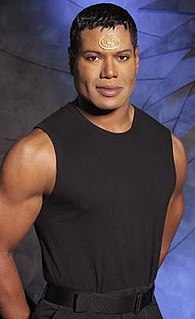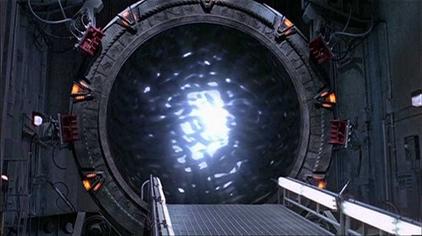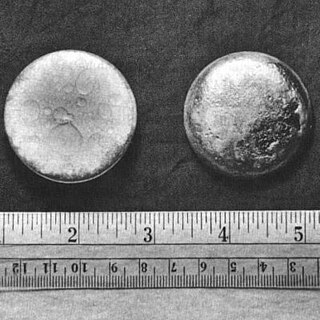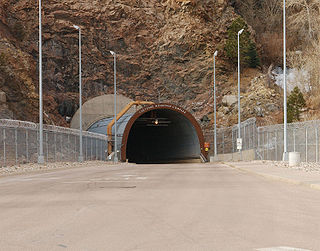
Teal'c is a fictional character in the military science fiction television series Stargate SG-1. Played by Christopher Judge, Teal'c is a Jaffa warrior from the planet Chulak. As a Jaffa, Teal'c is a genetically modified human with an abdominal pouch that serves as an incubator for a larval Goa'uld. The larval symbiote grants enhanced strength, health, healing, and longevity; Teal'c is around 100 years old during the show's run and ages an additional 50 years in the final SG-1 episode. Teal'c's most notable feature is a golden tattoo found on his forehead, a sign that he once served the System Lord Apophis as First Prime, the most senior Jaffa rank.
The Tok'ra are a fictional alien race on the science fiction television series Stargate SG-1. They first appear in the season 2 episode "In the Line of Duty". In the show, the Tok'ra are biologically the same species as the Goa'uld who inhabit human hosts in a symbiotic relationship, and are opposed to the evil System Lords. They are one of the major offworld allies of Stargate Command.

The Asgard are a highly advanced, fictional extraterrestrial race in the science fiction series Stargate SG-1 and Stargate Atlantis. They are first mentioned in the episode "Thor's Hammer", and first seen in "Thor's Chariot". In the series, the Asgard gave rise to Norse mythology on Earth, as well as accounts of the Roswell "Greys". Due to their technological Prowess, the Asgard are critical allies in Earth's fight against the Goa'uld, and later the Ori. The Asgard characters on the show are realized through a combination of puppets and computer-generated imagery.

In the military science fiction series Stargate SG-1, the Replicators are antagonistic self-replicating machines that are driven to replicate by consuming both alloys and technologies of the nearest most advanced civilization and constructing themselves and their progeny accordingly. They were first mentioned indirectly in the season 3 episode "Fair Game", and first seen onscreen in "Nemesis". In the show, the Replicators are primarily the enemies of the Asgard race, however, they act like a plague against all life thus, in the series, Earth must also contend with them on several occasions. The Asurans in the spin-off series Stargate Atlantis might be related to those in Stargate SG-1 as they are essentially human-form "Replicators".
In the fictional universe of the science fiction TV show Stargate SG-1, the Kull Warriors are creatures created by the Goa'uld Anubis for use as his personal army.
In the fictional universe of the Stargate franchise, the people of Earth have encountered numerous extraterrestrial races on their travels through the Stargate. In addition to a diversity of alien life, there is also an abundance of other humans, scattered across the cosmos by advanced aliens in the distant past. Some of the most significant species in Stargate SG-1 are the Goa'uld, the Asgard, and the Replicators. Stargate Atlantis, set in the Pegasus galaxy, introduced the Wraith and the Asurans. One of the most influential species in Stargate, the Ancients, have moved on to a higher plane of existence. For practical reasons of television productions, almost all of the alien and human cultures in the Stargate's fictional universe speak native English. Because of the time constraints of an hour-long episode, it would become a major hindrance to the story each week if the team had to spend a sizeable part of each episode learning to communicate with a new species.
"New Order" is the two-part Season 8 premiere of the science-fiction series Stargate SG-1. The episode earned a 2.4 Nielsen rating, a new record high for the show during its run on cable, which has since been tied, but never beaten. It also became the most-watched regular series episode ever for the Sci Fi Channel and the highest rated episode in the history of Stargate SG-1, drawing 3.22 million viewers. Part 2 was nominated for a Gemini Award in the category "Best Visual Effects".)
This is a list of the Goa'uld characters that appear in Stargate, Stargate SG-1, and Stargate Atlantis. In the Stargate fictional universe, the Goa'uld are a parasitic alien race that use other beings as hosts. Ra had stated in the original Stargate film that he had used humans exclusively as hosts for millennia, because Goa'uld technology can repair human bodies so easily that by inhabiting human forms they can be in effect ageless, though they can still be injured or killed. Most Goa'uld pose as gods in order to control slave armies, and are considered evil, egocentric megalomaniacs by those who do not worship them. The Goa'uld are extremely intelligent and have an aptitude for understanding, working with, and using technology that is superior to that of humans. They each have full access to their species' genetic memory from the moment of birth. As a result, no Goa'uld has to learn how to operate any technological device; they 'know' how to do so innately.

Stargate Worlds was to be a massively multiplayer online role-playing game (MMORPG) video game, but it was put on hold and never released. It was developed by Cheyenne Mountain Entertainment (CME) in association with Metro-Goldwyn-Mayer (MGM) and would have been published by FireSky for Microsoft Windows. The game's setting was based on the military science fiction series Stargate SG-1. The game was to focus on a premise set around an ancient device called the "Stargate".
This is a list of Goa'uld technologies in the Stargate franchise. The Goa'uld are the main adversaries for most of the run of Stargate SG-1. They scavenged or conquered most of their advanced technologies from other races. However, there are innovators amongst the Goa'uld; Anubis and Ba'al in particular have been depicted with a great deal of technological ingenuity. Rather than being designed as practical, many Goa'uld devices, such as the staff weapon, are designed to have higher visual impact, meant to intimidate and reinforce their position as gods to their followers. Some pieces of Goa'uld technology, such as the hand device and the healing device, respond only to mental commands and require naqahdah in the bloodstream of the user to operate.
In the Stargate fictional universe, the Ancients, also known as the Alterans and Lanteans, are the most advanced race known to have existed, having evolved millions of years prior to the present day and reaching their level of technology long before Human life evolved on Earth.















